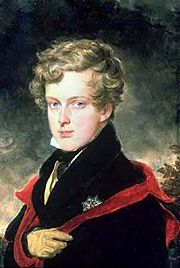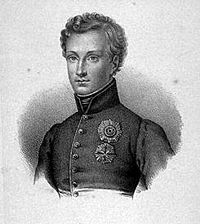Napoleon II
- "Duke of Reichstadt" redirects here.
- For other persons named Napoleon, see Napoleon (disambiguation).
| Napoléon II | ||
|---|---|---|
| Emperor of the French King of Rome Duke of Reichstadt | ||

| ||
| Reign | 22 June-7 July 1815 | |
| Coronation | 22 June 1815 | |
| Full name | Napoléon François Joseph Charles Bonaparte | |
| Titles | King of Rome | |
| Born | 20 March 1811 | |
| Paris, France | ||
| Died | 22 July 1832 (aged 21) | |
| Schönbrunn Palace, Vienna, Austria | ||
| Predecessor | Napoleon I | |
| Successor | De Facto Louis XVIII De Jure Joseph Bonaparte | |
| Royal House | Bonaparte | |
| Father | Napoleon I of France | |
| Mother | Marie Louise, Duchess of Parma | |
Napoléon François Joseph Charles Bonaparte, Duke of Reichstadt (March 20, 1811 – July 22, 1832) was the son of Napoleon Bonaparte and his second wife, Marie Louise of Austria. Known from birth as the King of Rome, he was styled as His Majesty the King of Rome, which Napoleon I declared was the courtesy title of the heir-apparent. He was named the second Emperor of the French after Napoleon's abdication in 1815 following his defeat at the Battle of Waterloo, although he did not exercise any power and was never officially recognized by the French state, who had placed Louis XVIII as king on April 6 1914 and again recognized him as king from July 8 1815 after Napoleon's 100 days of renewed rule (during which he had fled from Paris). Napoleon II's titular reign is dated from June 22 until July 7 1815.
Biography
Three years after his birth in Paris, the First French Empire — to which he was heir — collapsed, and Napoleon abdicated the throne in favour of his infant son, who was taken by the empress to Château de Blois in April 1814. In 1815, after his defeat at Waterloo, Napoleon again abdicated in favor of his son whom he had not seen since his exile to Elba.
=Accession
The Chamber of Representatives and Chamber of Peers recognized him as Emperor from the moment of his father's abdication (June 22, 1815), but the entrance of the Allies into Paris on July 7 brought a rapid end to his regime. The next Bonaparte to come to the throne of France (in 1851) took the name Napoleon III in deference to his cousin's mostly theoretical reign.
In 1814, the French restored the monarchy with Louis XVIII of France as king, having imprisoned Napoleon on Elba. Escaping from there in February, 1915 he embarked on the final 100 days of his reign (March 1 to June 22), which ended with a few days after his defeat at Waterloo. Abdicating in favor of Napoleon II was symbolic since Louis was already king. When he was exiled to Elba, he had been allowed to retain the title of Emperor even though Louis was king. When Louis died in 1824, he was succeeded by his younger brother, Charles X of France, which left Napoleon II as the Bonaparte pretender. After 1815, the young prince, now known as "Franz," after his maternal grandfather, rather than as "Napoleon," was a virtual captive in Austria where his mother had taken him for safety. He was awarded the title of Duke of Reichstadt in 1818. Chancellor Metternich was able to use the Duke in his diplomatic dealings with France. Bonaparte supporters continued to recognize his claim on the throne, and agitated in his name. He played little or no role in any of this, suffering from tuberculosis.
Death
Napoleon II died of tuberculosis at Schönbrunn Palace in Vienna on July 22, 1832. Upon the death of his stepfather, Neipperg, and the revelation that his mother had borne two illegitimate children to him prior to their marriage, Franz said to his friend, Prokesch von Osten, "If Josephine had been my mother, my father would not have been buried at Saint Helena, and I should not be at Vienna. My mother is kind but weak; she was not the wife my father deserved".[1]
It has been suggested[2] that his death was the result of deliberate lead or arsenic poisoning at the hands of agents of Metternich's police state.
He was very close to Princess Sophie of Bavaria and it has been further suggested that he was the father to her son, the future ill-fated Emperor Maximilian I of Mexico.[3]
Legacy
In 1940, the remains of Napoléon François Joseph Charles Bonaparte were transferred from Vienna to the dome of Les Invalides in Paris. This was done as a gift to France from German dictator Adolf Hitler. The remains of Napoleon I were moved there in 1840. For some time, the young prince rested beside his father.
Later the remains of Napoléon François Joseph Charles Bonaparte were moved to the lower church. While most of his remains were transferred to Paris, his heart and intestines remained in Vienna. They are in Urn 42 in the "Heart Crypt" (Herzgruft) and his viscera are in Urn 76 of the Ducal Crypt.
Napoléon François Joseph Charles Bonaparte was also known as "The Eaglet" (L'Aiglon). Edmond Rostand wrote a play, L'Aiglon, about his life. Serbian composer Petar Stojanović composed an operetta "Napoleon II: Herzog von Reichstadt," which premiered in Vienna in the 1920s.
Publications
- Welschinger, Le roi de Rome, 1811-32, (Paris, 1897)
- Wertheimer, The Duke of Reichstadt, (London, 1905)
ReferencesISBN links support NWE through referral fees
- ↑ Markham, Felix, Napoleon, p.249
- ↑ Altman, Gail S. Fatal Links: The Curious Deaths of Beethoven and the Two Napoleons (Paperback). Anubian Press (September 1999). ISBN 1-888071-02-8
- ↑ Maximilian and Carlota by Gene Smith, ISBN-10: 0245524185, ISBN-13: 978-0245524189
Ancestry
Template:Bonaparte
| 16. Sebastiano Nicolo Buonaparte | ||||||||||||||||
| 8. Giuseppe Maria Buonaparte | ||||||||||||||||
| 17. Maria-Anna Tusilo di Bocognano | ||||||||||||||||
| 4. Carlo Buonaparte | ||||||||||||||||
| 9. Maria-Saveria Paravicini | ||||||||||||||||
| 2. Napoleon I of France | ||||||||||||||||
| 10. Giovanni Geronimo Ramolino | ||||||||||||||||
| 5. Letizia Ramolino | ||||||||||||||||
| 11. Angela Maria Pietrasanta | ||||||||||||||||
| 1. Napoleon II of France | ||||||||||||||||
| 24. Francis I, Holy Roman Emperor | ||||||||||||||||
| 12. Leopold II, Holy Roman Emperor | ||||||||||||||||
| 25. Maria Theresa of Austria | ||||||||||||||||
| 6. Francis II, Holy Roman Emperor | ||||||||||||||||
| 26. Charles III of Spain | ||||||||||||||||
| 13. Maria Louisa of Spain | ||||||||||||||||
| 27. Maria Amalia of Saxony | ||||||||||||||||
| 3. Marie Louise of Austria | ||||||||||||||||
| 28. Charles III of Spain (= 26) | ||||||||||||||||
| 14. Ferdinand I of the Two Sicilies | ||||||||||||||||
| 29. Maria Amalia of Saxony (= 27) | ||||||||||||||||
| 7. Maria Teresa of the Two Sicilies | ||||||||||||||||
| 30. Francis I, Holy Roman Emperor (= 24) | ||||||||||||||||
| 15. Marie Caroline of Austria | ||||||||||||||||
| 31. Maria Theresa of Austria (= 25) | ||||||||||||||||
| House of Bonaparte Born: 20 March 1811; Died: 22 July 1832 | ||
|---|---|---|
| Regnal Titles
| ||
| Preceded by: Napoleon I |
Emperor of the French 22 June – 7 July 1815 |
Succeeded by: Louis XVIII |
| Titles in pretence
| ||
| New Title Bourbon Restoration |
* NOT REIGNING * Emperor of the French (7 July 1815 – 22 July 1832) |
Succeeded by: Joseph Bonaparte |
| Chronology of French monarchs from 987 to 1870 |
|---|
Hugues (987-996) • Robert II (996-1031) • Henri I (1031-1060) • Philippe I (1060-1108) • Louis VI (1108-1137) • Louis VII (1137-1180) • Philippe II (1180-1223) • Louis VIII (1223-1226) • Louis IX (1226-1270) • Philippe III (1270-1285) • Philippe IV (1285-1314) • Louis X (1314-1316) • Jean I (1316) • Philippe V (1316-1322) • Charles IV (1322-1328) • Philippe VI (1328-1350) • Jean II (1350-1364) • Charles V (1364-1380) • Charles VI (1380-1422) • Charles VII (1422-1461) • Louis XI (1461-1483) • Charles VIII (1483-1498) |
Louis XII (1498-1515) • François I (1515-1547) • Henri II (1547-1559) • François II (1559-1560) • Charles IX (1560-1574) • Henri III (1574-1589) |
Henri IV (1589-1610) • Louis XIII (1610-1643) • Louis XIV (1643-1715) • Louis XV (1715-1774) • Louis XVI (1774-1792) |
Napoléon I (1804-1814) |
Louis XVIII (1814-1815) |
Napoléon I (1815) • Napoléon II (1815) |
Louis XVIII (1815-1824) • Charles X (1824-1830) • Louis XIX (1830) • Henri V (1830) |
Louis-Philippe (1830-1848) |
Napoléon III (1852-1870) |
Template:French Pretenders
br:Napoleon II
Credits
New World Encyclopedia writers and editors rewrote and completed the Wikipedia article in accordance with New World Encyclopedia standards. This article abides by terms of the Creative Commons CC-by-sa 3.0 License (CC-by-sa), which may be used and disseminated with proper attribution. Credit is due under the terms of this license that can reference both the New World Encyclopedia contributors and the selfless volunteer contributors of the Wikimedia Foundation. To cite this article click here for a list of acceptable citing formats.The history of earlier contributions by wikipedians is accessible to researchers here:
The history of this article since it was imported to New World Encyclopedia:
Note: Some restrictions may apply to use of individual images which are separately licensed.
